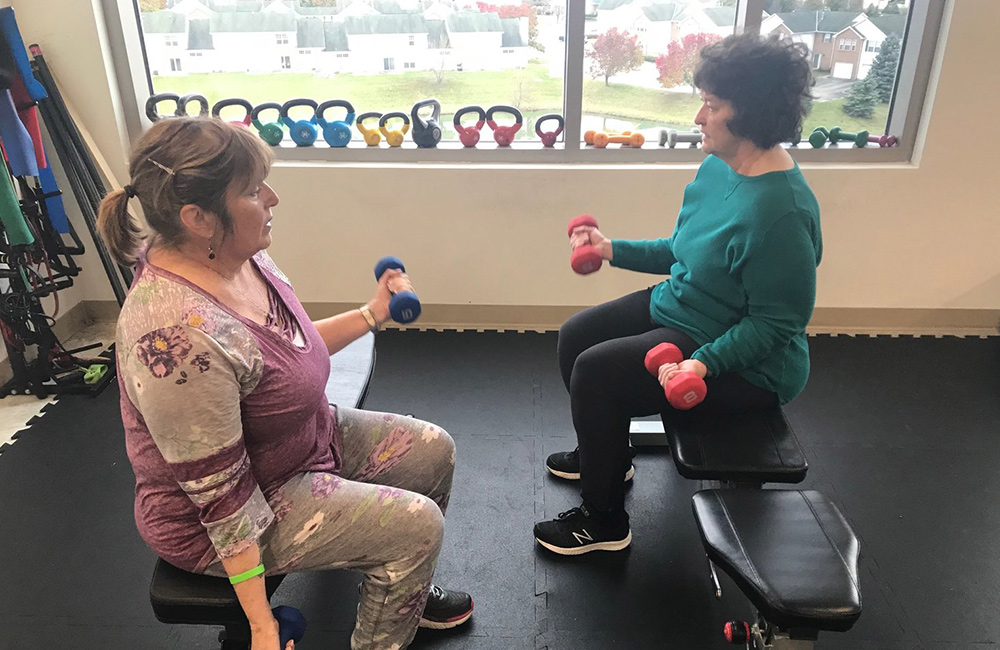As we have grown Maple Tree and developed partnerships with new hospital networks, we seem to be having the same conversation over and over again. It goes a little like this:
New Hospital Partner: “Your program looks great and your research is very compelling. Sooooo, can’t you just do all this in a group setting?”
In other words, they want to know what the big deal is with our individualized exercise training. Why not get more bang for our buck and work with a large group of people?
And I get it. I totally understand where this question comes from.
Look at it this way – If we work a full, 8-hour day, under our traditional model of individualized exercise oncology, we are able to conduct 8 exercise sessions. Therefore, we are able to serve 8 people that day.
However, if instead, we offered 8 group classes during that same day, we could probably serve ten times as many people.
On the surface it seems logical. Work the same number of hours, but serve more people. After all, more is better – isn’t it??
Today, I’d like to challenge this way of thinking…. At least as it pertains to exercise in a cancer population. In this situation, I believe – and my research would support – that quality is way more important than quantity.
This line of thought is what led us to conduct the study highlighted in this week’s blog.
Based on the existing data supporting research in a cancer population, as well as conversations like the one described above, our lab set out to compare patient outcome in a group-based exercise program with that of an individualized exercise program.
Methods
This controlled trial evaluated the effects of a group exercise intervention versus individualized exercise therapy in a total of 573 newly diagnosed cancer survivors. An ethical committee of the recruiting cancer center approved this study prior to the onset of any data collection.
A total of 296 patients served as subjects in the group exercise intervention and 308 patients comprised the group of individualized exercise training. Both interventions lasted for 12-weeks.
Baseline assessments were measured on both groups as the start of the program, and again at the completion of the 12-week exercise intervention. Fitness parameters (body composition, cardiorespiratory endurance, musculoskeletal fitness), as well as overall quality of life and psychological measures (depression, anxiety) were measured for both groups. Mean scores for fitness parameters and quality of life measures were calculated for the complete sample. Compliance data was also measured for each group. The data were averaged and analyzed using a one-way ANOVA test. All data was analyzed at the 0.05 level of significance.
Results
Exercise had a positive impact on fitness parameters for both groups. Muscular strength, muscular endurance, and flexibility significantly improved from baseline levels in both the individualized and group-based intervention (p<0.05).
The individualized exercise group experienced greater improvements in cardiovascular endurance, muscular strength, and muscular endurance (p<0.05) than the group exercise counterparts. There were no significant differences between groups for flexibility and body composition.
Mean depression and anxiety scores improved in both groups, but to a greater extent in the individualized exercise group. This group reported significantly lower levels of depression (IEx = 2.25 ± 0.3, GEx = 5.4 ± 0.4; p < 0.05) and anxiety (IEx = 3 ± 0.25, GEx = 4.2 ± 0.6; p< 0.05) than their group exercise counterparts.
Finally, the individualized exercise group had the highest exercise compliance rate (87% vs. 76% in the GEx group, p<0.05).
Conclusion
This study aimed to examine the difference between group exercise versus individualized exercise instruction. Our data found that both forms of exercise improved fitness parameters during cancer treatment, however, the individualized approach was found to be effective at improving fitness levels and exercise compliance. Further, individualized exercise instruction had a greater impact on psychological parameters.
Application
At the end of the day, the best take-home message I can offer to you is to MOVE YOUR BODY during cancer. Yes, there will be days when you don’t feel like it. When you’re just too tired or too sick to try. But on those days, even a quick 5-minute walk to your mailbox will do wonders for your health!
Obviously, I am a proponent of individualized exercise training as the BEST approach to exercise oncology. As the American Cancer Society points out on their website, “cancer therapies aren’t ‘one size fits all’ “. As such, I believe that our approach to exercise shouldn’t be either. This is why I will continue to offer individualized exercise programming in my facilities.
BUT – as you can see from our study – both group and individualized instruction improve fitness and psychological health…. Just to a greater extent with individualized exercise. Therefore, if you just LOVE your zumba class – hear me tell you that you can keep doing it!! Don’t quit!!! If you have never exercised before and are too intimidated to walk into a gym by yourself – group exercise might be a good way to get started. So give it a try!!! Whatever it takes to get you to move your body!
Less depression. Less anxiety. More endurance. More strength.
Think of how proud of yourself you will be once you give it a try!

